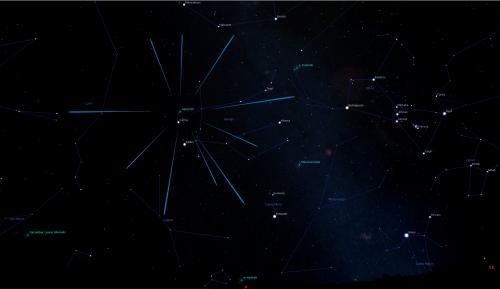Celebration of Space - December 9, 2022
This coming Tuesday, December 13, 2022, the annual Geminid Meteor Shower peak will occur. The Geminid peak is the best meteor shower peak of the year, bringing with it upwards of 150 meteors per hour in addition to regular meteor activity. The peak will last all night into the morning hours of Wednesday, December 14, 2022. Though in 2022, the peak will not be as visibly active as prior years, and that is due to the presence of the 75% waning gibbous Moon, which will rise at 9:15 pm ET. Considering that this meteor shower happens quite close to the Winter Solstice, several hours of meteor watching, under dark sky conditions, can still happen, though once the Moon rises, only the brightest meteors will be visible.
The Geminid Meteor Shower is a product of the inactive comet – 3200 Phaethon, which is currently classified as an asteroid. As 3200 Phaethon orbits the Sun, it leaves a very dense debris field along its orbit. Every November 19th – December 24th, Earth will pass through this debris field. Tiny particles of comet, mostly ice, are captured by Earth’s gravity, and enter Earth’s atmosphere at speeds of 21 miles per second. At that rate, these tiny particles burn up when encountering the atmosphere and streak across the sky. At Frosty Drew we have observed that Geminid meteors often appear blue / green in color, and are often followed quickly by several dimmer meteors that quickly flash, resembling water drops.
To catch sight of the Geminid Meteor Shower this year, set out to a location with a wide open view of the night sky that is not illuminated, and that does not have a lot of light pollution. Be there for 6:00 pm and lay on your back with your feet orientated towards the southeast, and look to the zenith (top of the sky) to spot meteors streaking by. Meteors will appear to radiate from the bright star Castor in the constellation Gemini, which is how the meteor shower gets its name. Even though the Moon will eventually interfere with the view, the first few hours can be quite spectacular.
Frosty Drew Observatory and Science Center will be hosting an event for the Geminid Meteor Shower peak on Tuesday, December 13, 2022, starting at 6:30 pm and going until 10:00 pm. We will have telescopes set up in the Observatory Courtyard with views of Mars, Jupiter, the Andromeda Galaxy, Pleiades, and more. The Sky Theatre and Science Center will be open to offer a respite from the cold. Tickets are required to attend and can be purchased.
On Sunday, December 11, 2022 at 12:40 pm EST, the NASA Artemis mission, which has been on a trip to the Moon and back, will re-enter Earth’s atmosphere and splashdown in the Pacific Ocean. The Artemis mission is the mission to bring a human presence to the Moon. This presence will be in the form of a lunar base station and an orbiting space station. The mission that is currently in space is called Artemis-1, which launched from Kennedy Space Center on November 16, 2022, departed Earth and traveled to the Moon. Once at the Moon, the Orion crew module orbited around the far side of the Moon, then departed lunar orbit. As of December 8th, the Orion module was traveling at 1,415 mph heading back to Earth, with only 207,200 miles remaining. Artemis-1 is uncrewed, and serves as a test mission for future human supporting missions. NASA TV will begin live coverage of the splashdown starting at 11:00 am ET on December 11th. In the meantime, take a moment to catch up on the mission, including a live, real-time video stream from Orion: https://www.nasa.gov/artemislive/. Note that the capsule has intermittent bandwidth issues and will broadcast when acceptable bandwidth is available. You can also check out the image and video galleries of the Artemis-1 mission. While you’re at it, check out this quick video compilation showing some of the memorable moments of the mission. Go NASA!
Now that the International Space Station (ISS) has completed its evening passes over the US for the current pass cycle, the station has retreated into the early predawn morning sky. Though China’s space station – Tiangong has a few more evening passes in store over the next several nights for US sky watchers. Tiangong is not as big as the ISS, but it is modular, and continues to expand. What was once a rather dim satellite passing over, has now grown into one of the brightest. Here are a few notable pass times for the coming nights:
Fri, Dec 9 at 5:36 pm, starting in the W, rising to 46º, heading towards the SE, and into orbital sunset.
Sat, Dec 10 at 6:15 pm, starting in the WSW, rising to 19º, and into orbital sunset
Sun, Dec 11 at 5:17 pm, starting in the W, rising to 29º, heading towards the SE
Tue, Dec 13 at 4:57 pm, starting in the WSW, rising to 17º, heading towards the SSE
These pass times are applicable to Southern New England, and are generally acceptable for the entire Northeast region. Now get out there and celebrate the longest nights of the year with a view of Tiangong passing over.
- Author:
- Scott MacNeill
- Entry Date:
- Dec 9, 2022
- Published Under:
- Scott MacNeill's Columns





